视觉导航弊端多 塔波尔视觉扫地机器人遭质疑
2019年“全球十大突破性技术”发布 灵巧机器人等入选
2018-2019VEX机器人亚洲公开赛 西安交大再夺冠
伯克利和Deepmind前赴后继,只为教出一个会做家务的机器人?
Brain code can now be copied for AI, robots, say researchers
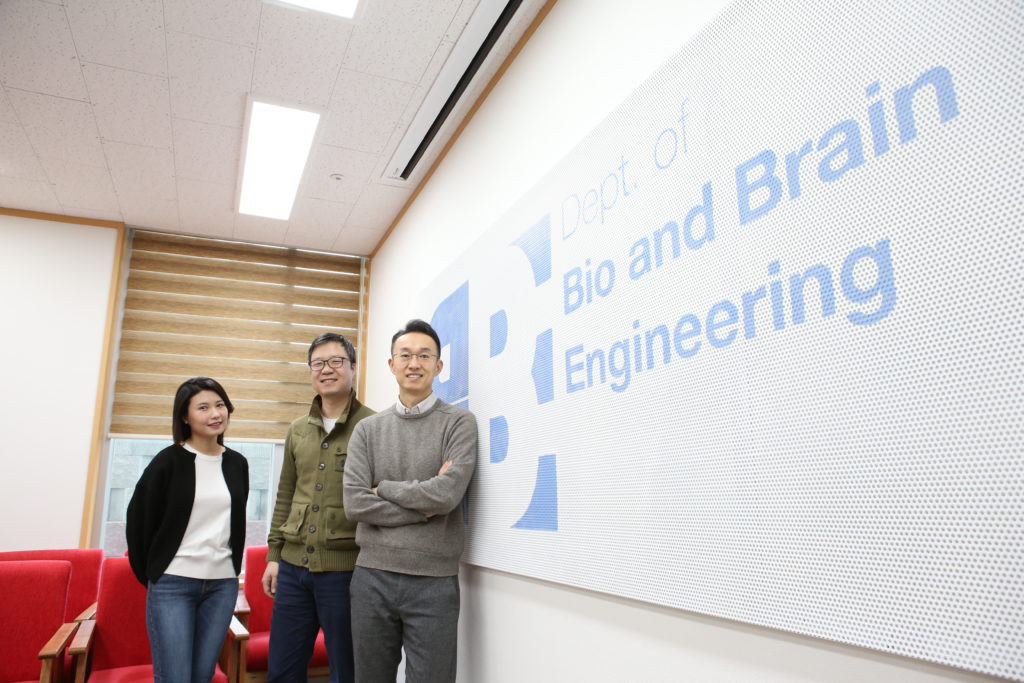
KAST researchers exploring the human brain as a model for robots, from left: Ph.D. candidate Su Jin An, Dr. Jee Hang Lee, and Prof. Sang Wan Lee. Source: KAIST
Researchers at the Korea Advanced Institute of Science and Technology (KAIST), the University of Cambridge, Japan’s National Institute for Information and Communications Technology (NICT), and Google DeepMind have argued that our understanding of how humans make intelligent decisions has now reached a critical point. Robot intelligence can be significantly enhanced by mimicking strategies that the human brain uses when we make decisions in our everyday lives, they said last week.
In our rapidly changing world, both humans and autonomous robots constantly need to learn and adapt to new environments. But the difference is that humans are capable of making decisions according to the unique situations, whereas robots still rely on predetermined data to make decisions.
Rapid progress has been made in strengthening the physical capability of robots. However, their central control systems, which govern how robots decide what to do at any one time, are still inferior to those of humans. In particular, they often rely on pre-programmed instructions to direct their behavior, and lack the hallmark of human behavior, that is, the flexibility and capacity to quickly learn and adapt.
Applying neuroscience to the robot brain
Applying neuroscience in robotics, Prof. Sang Wan Lee from the Department of Bio and Brain Engineering at KAIST and Prof. Ben Seymour from the University of Cambridge and NICT proposed a case in which robots should be designed based on the principles of the human brain. They argue that robot intelligence can be significantly enhanced by mimicking strategies that the human brain uses during decision-making processes in everyday life.
The problem with importing human-like intelligence into robots has always been a difficult task without knowing the computational principles for how the human brain makes decisions — in other words, how to translate brain activity into computer code for the robots’ “brains.”
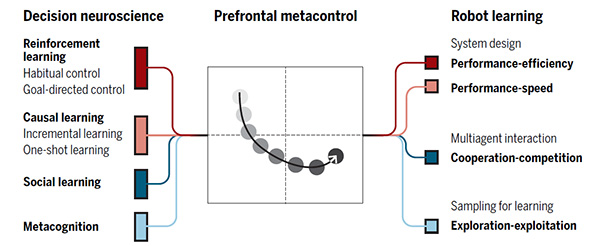
Brain-inspired solutions to robot learning. Neuroscientific views on various aspects of learning and cognition converge and create a new idea called “prefrontal metacontrol,” which can inspire researchers to design learning agents for key challenges in robotics such as performance-efficiency-speed, cooperation-competition, and exploration-exploitation trade-offs (Science Robotics)
However, researchers now argue that, following a series of recent discoveries in the field of computational neuroscience, there is enough of this code to effectively write it into robots. One of the examples discovered is the human brain’s “meta-controller.” It is a mechanism by which the brain decides how to switch between different subsystems to carry out complex tasks.
Another example is the human pain system, which allows them to protect themselves in potentially hazardous environments.
“Copying the brain’s code for these could greatly enhance the flexibility, efficiency, and safety of robots,” said Prof. Lee.
An interdisciplinary approach
The team argued that this inter-disciplinary approach will provide just as many benefits to neuroscience as to robotics. The recent explosion of interest in what lies behind psychiatric disorders such as anxiety, depression, and addiction has given rise to a set of sophisticated theories that are complex and difficult to test without some sort of advanced situation platform.
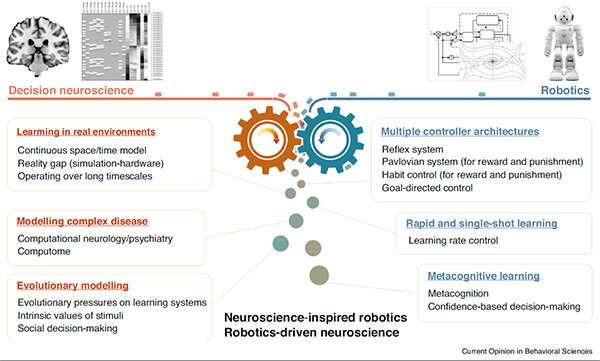
Overview of neuroscience-robotics approach for decision-making. The figure details key areas for interdisciplinary study (Current Opinion in Behavioral Sciences)
“We need a way of modeling the human brain to find how it interacts with the world in real-life to test whether and how different abnormalities in these models give rise to certain disorders,” explained Prof. Seymour. “For instance, if we could reproduce anxiety behavior or obsessive-compulsive disorder in a robot, we could then predict what we need to do to treat it in humans.”
The team expects that producing robot models of different psychiatric disorders, in a similar way to how researchers use animal models now, will become a key future technology in clinical research.
Sympathy for the robot
The team also stated that there may also be other benefits to humans and intelligent robots learning, acting, and behaving in the same way. In future societies in which humans and robots live and work amongst each other, the ability to cooperate and empathize with robots might be much greater if we feel they think like us.
“We might think that having robots with the human traits of being a bit impulsive or overcautious would be a detriment, but these traits are an unavoidable by-product of human-like intelligence,” said Prof. Seymour. “And it turns out that this is helping us to understand human behavior as human.”
The framework for achieving this brain-inspired artificial intelligence was published in two journals, Science Robotics on Jan. 16 and Current Opinion in Behavioral Sciences on Feb. 6, 2019.
The post Brain code can now be copied for AI, robots, say researchers appeared first on The Robot Report.
“写字机器人”模仿字迹功能有风险? 律师:恶意伪造他人签字涉嫌违法
国内智能巡检机器人发展现状及主要企业
Robotics cluster in Odense, Denmark, offers metrics for growth

What makes a robotics cluster successful? Proximity to university research and talent, government support of entrepreneurship, and a focus on industry end users are all important. Around the world, regions have proclaimed initiatives to become “the next Silicon Valley.” However, there have been relatively few metrics to describe robotics hubs — until now.
This week, Odense Robotics in Denmark released a report on the economic returns generated by its member companies. Both the amount of exports and the number of employees have increased by about 50 percent, according to Mikkel Christoffersen, business manager at Odense Robotics.
At the same time, the report is realistic about the ongoing challenges facing every robotics cluster, including finding qualified job candidates. As locales from India to Israel and Canada to China look to stimulate innovation, they should look at their own mixes of people, partnerships, and economic performance.
Membership and money
The Odense robotics cluster currently has 129 member companies and more than 10 research and educational institutions. That’s up from 85 in 2015 and comparable with Massachusetts, which is home to more than 150 robotics companies. The Massachusetts Robotics Cluster said it had 122 members as of 2016.
Silicon Valley Robotics says it has supported 325 robot startups, and “Roboburgh” in Pittsburgh includes more than 50 organizations..
In terms of economic performance, the Odense robotics cluster had 763 million euros ($866.3 million U.S.) in turnover, or revenue, in 2017. It expects another 20 percent increase by 2021.
Odense has been friendly to startups, with 64 founded since 2010. The Odense Robotics StartUp Hub has helped to launch 15 companies. Seventy companies, or 54 percent, of those in the Odense area have fewer than 10 employees.
Total investments in the Danish robotics cluster have risen from 322 million euros ($365.6 million) in 2015 to 750 million euros ($851.7 million) last year, with 42 percent coming from investors rather than public funding or loans.
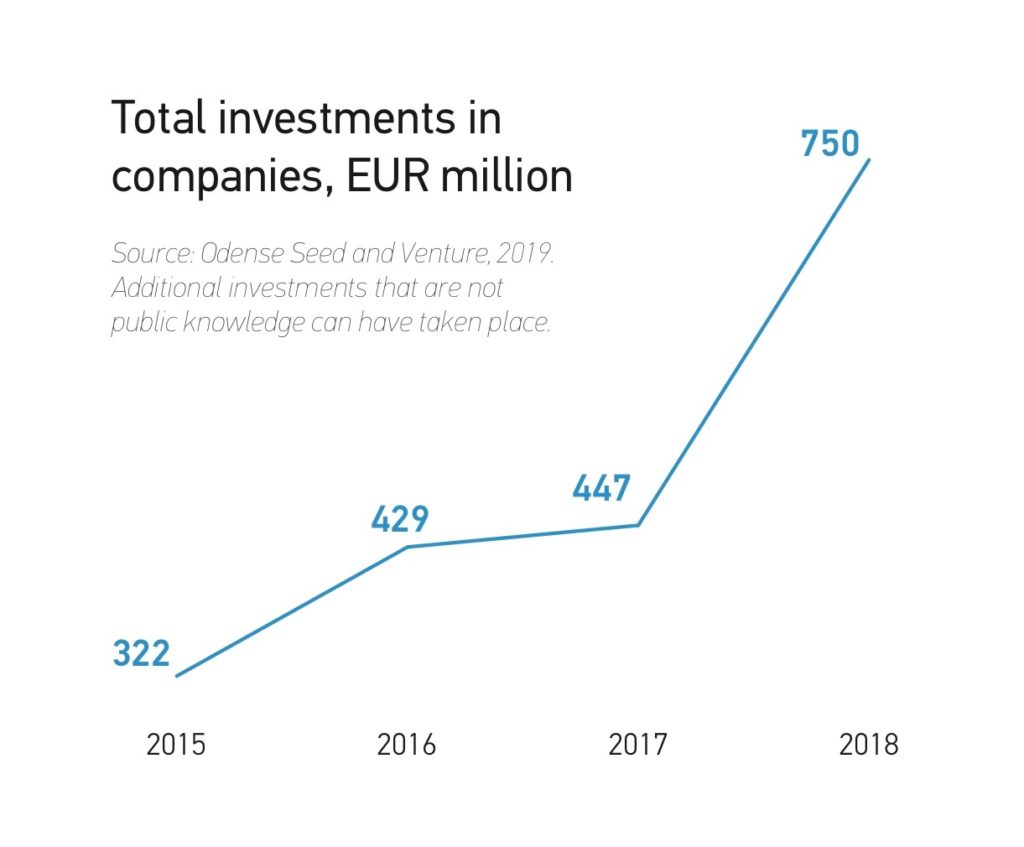
Source: Odense Robotics
In addition, 71 local companies were robotics producers, up from 58 in 2017. The next largest category was integrators at 23. The region also boasted 509 million euros ($577.9 million) in exports in 2017, and 66 percent of its members expect to begin exports.
Market focus
The Odense Robotics report notes that a third of its member companies work with collaborative and mobile robots, representing its focus on manufacturing and supply chain customers. Those are both areas of especially rapid growth in the wider robotics ecosystem.
The global collaborative robotics market will experience a compound annual growth rate (CAGR) of 49.8 percent between 2016 and 2025, compared with a CAGR of 12.1 percent for industrial robots, predicts ABI Research. Demand from small and midsize enterprises will lead revenues to exceed $1.23 billion in 2025, said ABI.
Odense-based Universal Robots A/S is the global market leader in cobot arms. Odense-based gripper maker OnRobot A/S was formed last year by the merger of three companies, and it has since acquired Purple Robotics and raised hundreds of millions in additional funding.
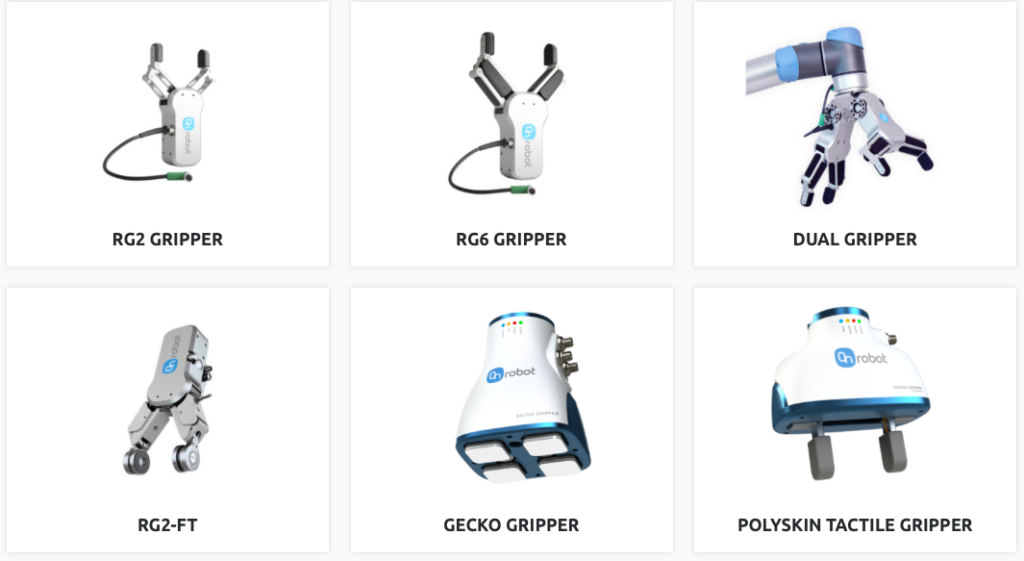
OnRobot’s lineup of robotic grippers. Source: OnRobot
Similarly, the market for autonomous mobile robots will have a 24 percent CAGR between 2018 and 2022, according to a Technavio forecast. Odense-based Mobile Industrial Robots ApS (MiR) has tripled its sales in each of the past two years.
Both Universal Robots and MiR have broadened their international reach, thanks to ownership by Teradyne Inc. in North Reading, Mass.
Robotics cluster must address talent shortage
Odense Robotics said that its robotics cluster employs 3,600 people today and expects that figure to rise to 4,900 by next year. In comparison, the Massachusetts robotics cluster employed about 4,700 people in 2016.
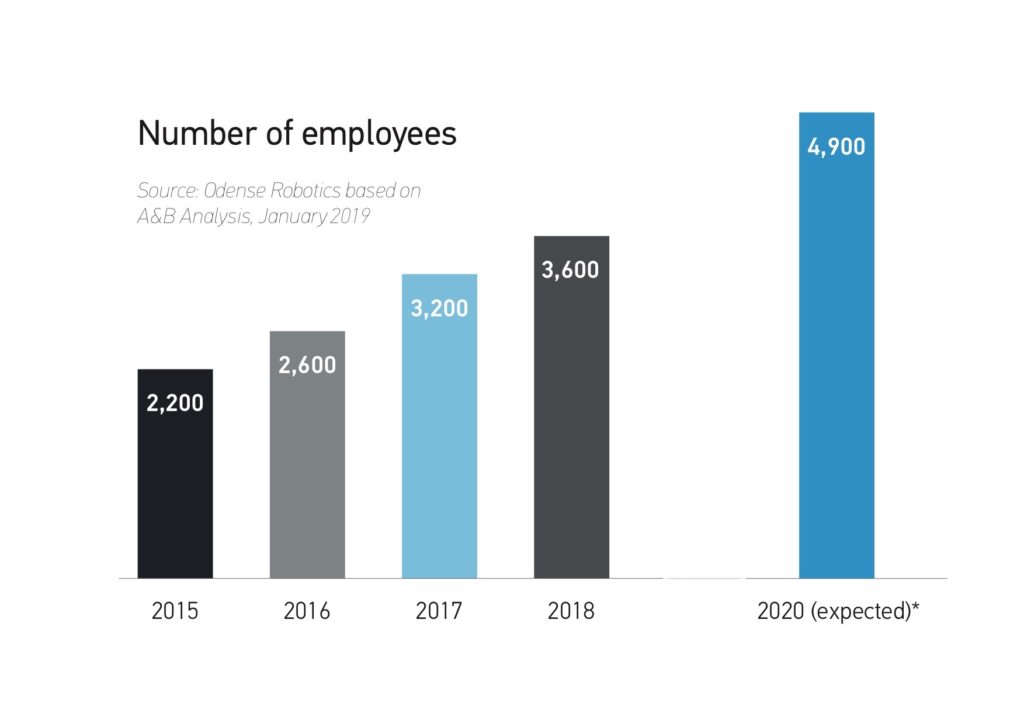
The Danish robotics cluster is a significant employer. Source: Odense Robotics
Even as the numbers of people grow at larger robotics companies (with 50 or more employees) or abroad, businesses in southern Denmark have to look far afield to meet their staffing needs. More than a third, or 39 percent, said they expect to hire from outside of Denmark, and 78 percent said that finding qualified recruits is the biggest barrier to growth.
The average age of employees in the Odense robotics cluster reflects experience, as well as difficulty recruiting. Fifty-five percent of them are age 40 to 60, while only 18 percent are under 30.
This reflects a larger problem for robotics developers and vendors. Even with STEM (science, technology, engineering, and mathematics) programs and attention paid to education, the demand for hardware and software engineers worldwide outstrips the available pool.
The University of Southern Denmark (SDU) is working to address this. It has increased admissions for its bachelor’s degrees in engineering and science and master’s of science programs from 930 in 2015 to 1,235 last year. The university also launched a bachelor’s in engineering for robot systems, admitting 150 students since 2017.
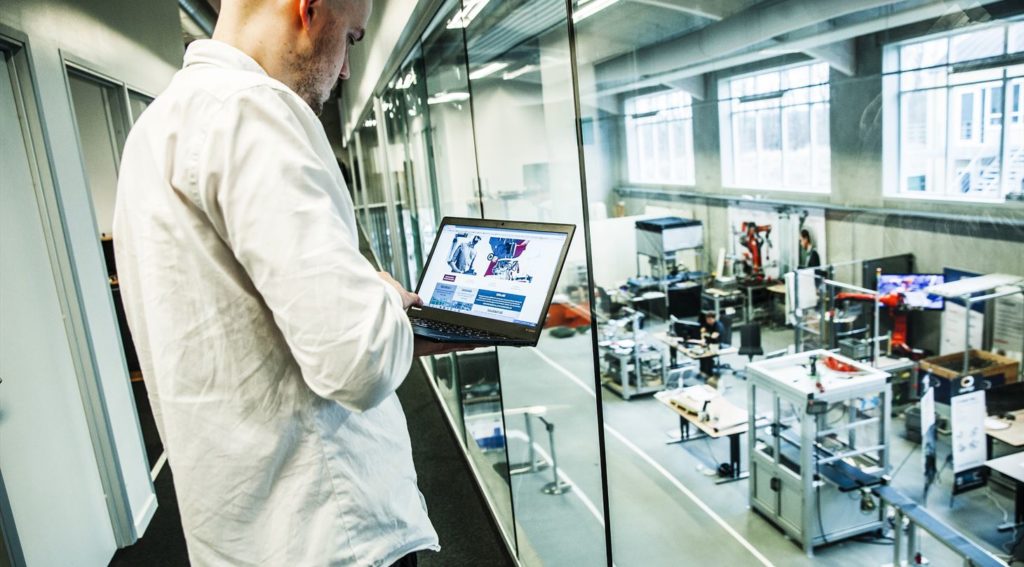
The Danish Technological Institute is expanding its facilities in Odense this year. Source: DTI
Another positive development that other robotics clusters can learn from Odense is that 41 percent of workers at robotics firms there went to vocational schools rather than universities.
Partnerships and prospects
Close collaboration with research institutions, fellow robotics cluster members, and international companies has helped the Odense hub grow. Seventy eight percent of cluster members collaborate among themselves, according to the report. Also, 38 percent collaborate with more than 10 companies.
The Odense robotics cluster grew out of a partnership between shipping giant Maersk A/S and SDU. The Maersk Mc-Kinney Moller Institute at SDU continues to conduct research into robotics, artificial intelligence, and systems for healthcare and the energy industry. It recently added aerial drones, soft robotics, and virtual reality to its portfolio.
Last year, the institute invested 13.4 million euros ($15.22 million) in an Industry 4.0 laboratory, and an SDU team won in the industrial robot category at the World Robot Summit Challenge in Japan.
Examples such as Universal Robots and MiR, as well as Denmark’s central position in Northern Europe, are encouraging companies to look for partners. Collaborating with companies inside and outside the Odense robotics cluster is a top priority of members, with 98 percent planning to make it a strategic focus in the next three years.
Of course, the big opportunity and competitive challenge is China, which is potentially a much bigger market than the U.S. or Europe and is trying to build up its own base of more than 800 robotics companies.
It’s only through collective action around robotics clusters that smart regions, large and small, can find their niches, build talent, and maximize the returns on their investments.
Editor’s note: A panel at the Robotics Summit & Expo in Boston on June 5 and 6, 2019, will feature speakers from different robotics clusters. Register now to attend.
The post Robotics cluster in Odense, Denmark, offers metrics for growth appeared first on The Robot Report.